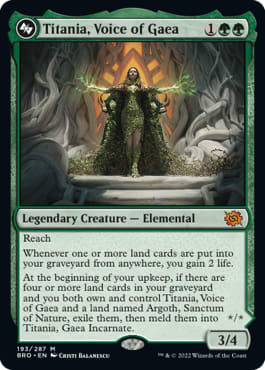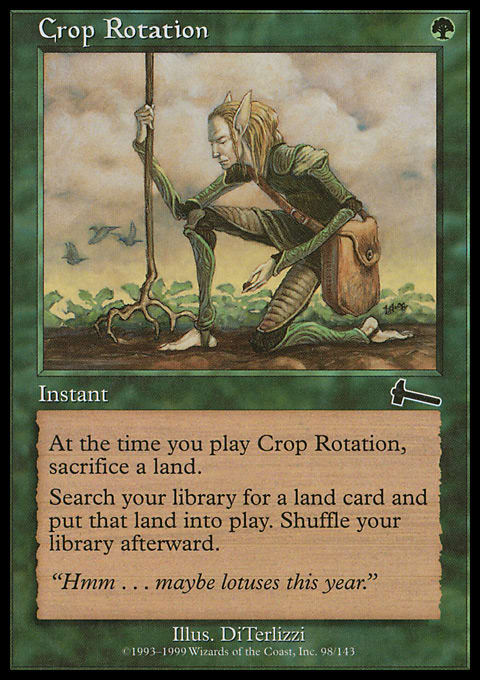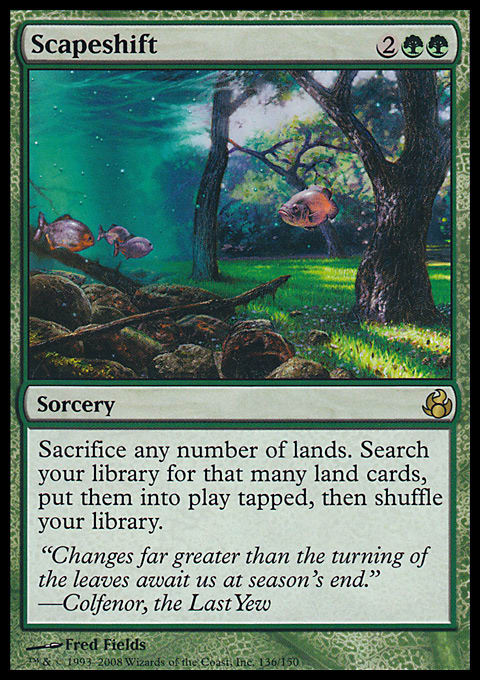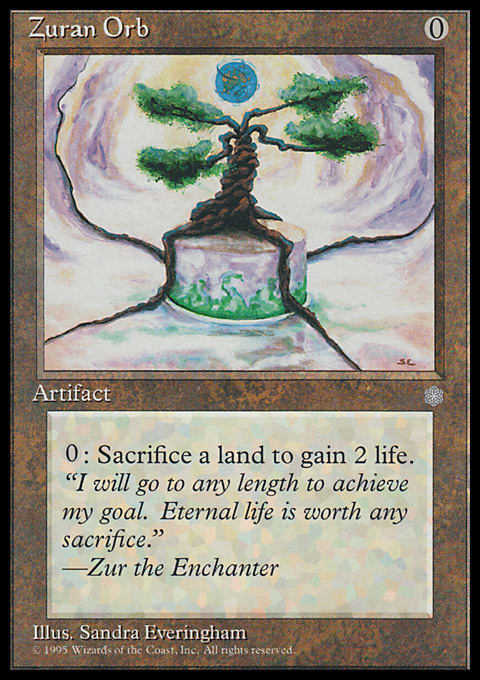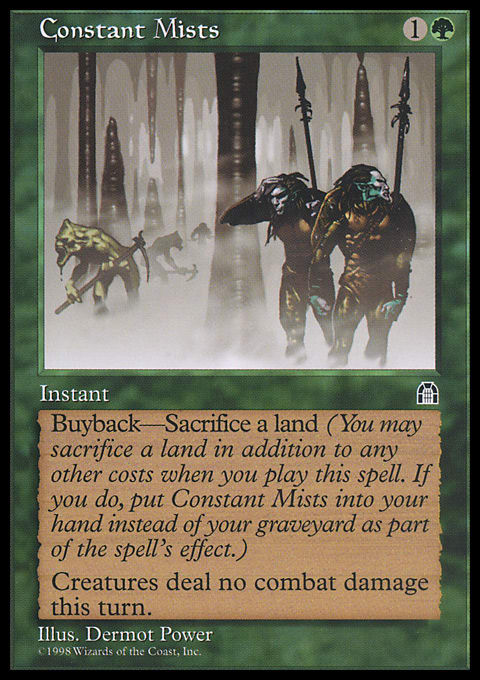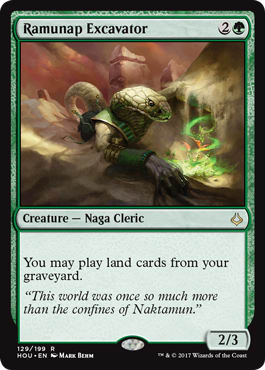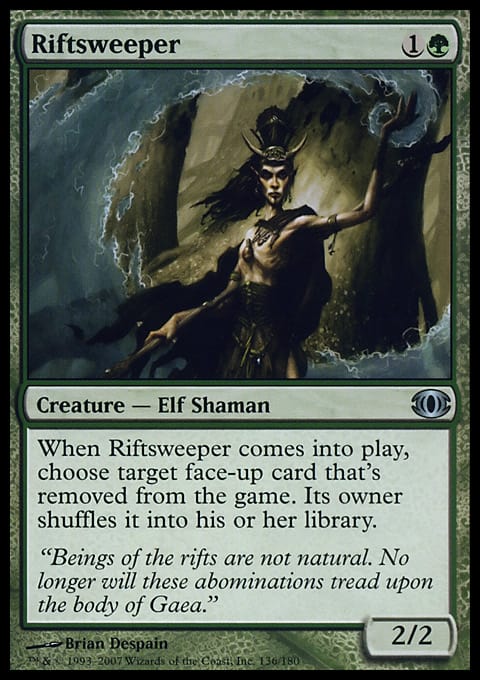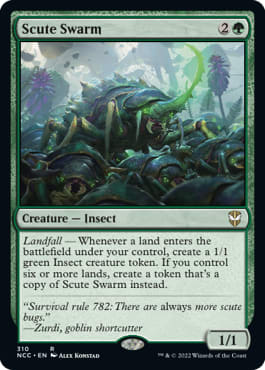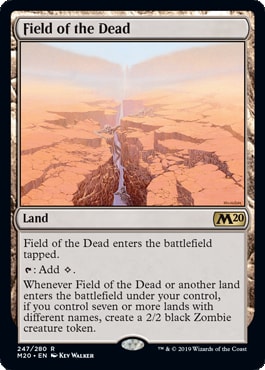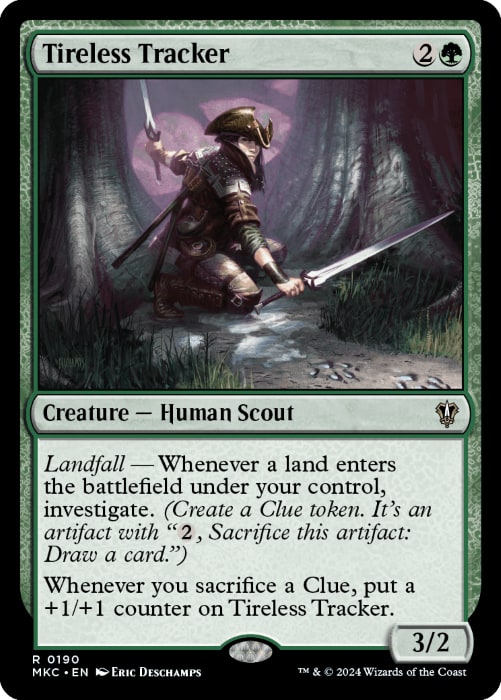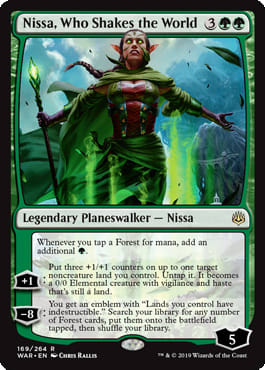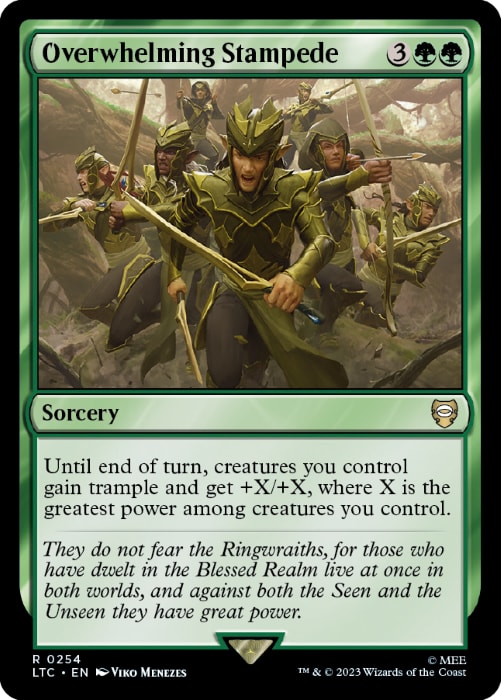Lands are one of Magic's most unique card types, separating it from other TCGs by adding an element of controllable randomness to your ability to produce mana and cast spells. Their mere existence as a game mechanic has an unfathomably vast impact on the shape of the game as a whole. I'd say they're a key component to its success and longevity. Green is the color that interacts most with lands, and because of that, Mono-Green lands is a tried and true archetype in Commander.
I don't currently have a Mono-Green Commander deck. Not an actual Mono-Green deck, anyways. I have a Sasaya, Orochi Ascendant deck, but it's not actually very good. It's a one trick pony: it either goes off and produces upward of forty mana, or I sit there and do literally nothing except fill my hand with lands the entire game. It's fun, but it's not the kind of deck you can play multiple times in succession without the novelty wearing thin. Because of that, I made the decision to build another Mono-Green deck, and a deck centered around lands seemed like a natural place to start.
I've liked Titania since she got her very first card. Titania, Protector of Argoth played with a unique space by rewarding you for sacrificing your lands by creating 5/3 tokens, but I didn't build her at the time. Now, she's on two more legendary creature cards. Titania, Nature's Force lets you play forests from your graveyard, and creates a 5/3 elemental when a forest enters the battlefield. On top of that, she even fuels herself, milling three cards when one of your elementals dies. While Nature's Force is undeniably powerful, she doesn't actually care about sacrificing lands. That's why her third card - Titania, Voice of Gaea - caught my eye. Well, that and one other thing.
Titania, Voice of Gaea has meld, a mechanic she shares with only four other commanders. A card with meld can be combined with a certain other card to become a powerful new form, twice the physical size of every other card on the table. Melded cards can be somewhat unwieldy to actually use, but at least in my opinion, they're cool enough to justify being a bit impractical. Note what I said earlier, however: a certain other card. If you want to use your commander's melded form with any regularity, it'll pretty much require you to play several cards in your deck that can search your library for the card your commander needs. This deck-building restriction can be problematic for commanders like Bruna, the Fading Light, since Mono-White can struggle to search for creatures, but it's not a huge obstacle for Titania. Argoth, Sanctum of Nature is a land, and Mono-Green is incredible at tutoring for lands.
Argoth, Sanctum of Nature on its own is a fairly simple land. It can conditionally enter untapped, and it produces Green mana. Argoth has an activated ability that, while I don't expect I'll use it much, is emblematic of what a Titania deck would want to do. It mills three cards and makes a token, creating board presence while you fill your graveyard. Milling lands will help fuel Titania, providing life gain from her triggered ability and bringing you closer to four lands in your graveyard - the secondary requirement for Titania to meld.
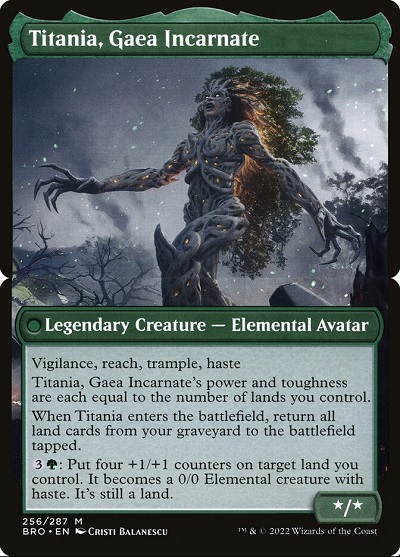
We're going through a lot of trouble to fulfill the conditions to meld Titania. Finding a single card in a hundred card deck and filling your graveyard with lands are sizable hoops to have to jump through, so I'm sure you're wondering what the actual payoff to all of this is. Titania, Gaea Incarnate is your answer. She makes for an excellent beatstick, with her power and toughness matching the number of lands you control, and a combination of vigilance, reach, trample, and haste. This is pretty impressive on its own, but there's a bit more to her. When she enters the battlefield, you return each land in your graveyard to the battlefield tapped. That's the real payoff to filling your graveyard with lands. It makes her even larger, and interacts incredibly well with landfall cards. On top of all that, she also has an activated ability. You can pay four mana to make one of your lands into a creature, and put four +1/+1 counters on it. I wouldn't say this ability is amazing, but it's a way to spend excess mana that would otherwise go to waste, and you can activate it at instant speed, which significantly improves its flexibility.
This deck's game plan will start with ramping in the early game and then setting up one of our landfall payoffs. When we can, we'll want to play Titania, since she provides lifegain and is a decent enough blocker, and we need her on the battlefield to be able to meld later on. At three mana, she's cheap enough that it's not a struggle to recast her if she dies. While we need Argoth, we don't necessarily want to tutor for it at the first opportunity. If we aren't resorting to using its activated ability, we don't need it until we're ready to meld Titania, so if we play it or search for it too early, we give our opponents information they can use against us. When we are ready, we can play Argoth, and hope it and Titania survive until our next turn. If they both do, we're in business, getting a huge creature and at least four landfall triggers, generating an enormous wave of advantage that we can hopefully use to take over the game.
Building Blocks
Let's start with some of the building blocks of that gameplan.
This landfall deck is going to need ramp, of course. On top of Nature's Lore and Three Visits, we'll be running Harrow, Roiling Regrowth, Springbloom Druid, and Entish Restoration. Each of these cards require you to sacrifice a land, but allow you to search for two basic lands and put them into play. At only three mana, this is extremely efficient, triggering landfall twice while putting a land in our graveyard. Harrow is the standout of the four, since each of the others put their lands into play tapped, but they're all worth running here.
We'll obviously need several ways to get Argoth out of our deck, and Crop Rotation is one of my favorites. For only one mana, and at instant speed, you can sacrifice a land to search your library for any land and put it into play. This spell is our most consistent way to get Titania melded. On top of filling our graveyard, it can put Argoth into play at instant speed, allowing you to spring it on your opponents on the end step before your turn. I can't emphasize enough how impressive it is for a one mana spell to be able to single handedly turn a mediocre board with Titania and not much else into a terrifying board with Titania and not much else.
I've always thought of Scapeshift as a scaled-up Crop Rotation. It's four mana and a sorcery, but you can sacrifice any number of lands, search for that many lands, and put them into play tapped. While sorcery speed means your opponents will have a turn to find an answer for Titania before she melds, Scapeshift makes up for that drawback by being able to put four lands in your graveyard on its own. It tutors for several nonbasic lands, allowing you to search for both Argoth and whatever else would be useful at the current time.
Sylvan Safekeeper is the beating heart of this deck. It does everything we need to support our strategy, and all for only one mana. It's a 1/1 creature with just a single activated ability: we can sacrifice a land to give a creature shroud. On top of protecting our creatures, including itself, the cost of that ability is incredibly important. Every time we sacrifice a land with Titania out, we gain two life. This can help us survive heavy damage, and if Titania melds, we get each and every land back. If we're confident we won't get blown out by removal, we can sacrifice all our lands that aren't Argoth to maximize our lifegain and landfall triggers. Really, the worst thing about Sylvan Safekeeper is that we can only play one copy of it.
While the Commander format's singleton nature isn't something we can avoid, we can mitigate the inconsistency it introduces with one simple thing: tutors. Green Sun's Zenith is a phenomenal creature tutor - for only a single Green mana and a payment of X, we can search our library for a Green creature with mana value X or less, put it into play, and shuffle Green Sun's Zenith into our library. For just a single extra mana, you can play Sylvan Safekeeper or any of our other creatures right from our library. This spell is unbelievably flexible, able to get whatever you need in the current situation. Since we're playing Dryad Arbor, we can even play it as a mana dork, spending one mana for a 1/1 that can tap for mana.
With Sylvan Safekeeper proving how powerful the ability to sacrifice lands can be, it's natural that we'd play a few other cards that can do that. Zuran Orb is a free artifact which can let us sacrifice a land to gain two life. With Titania out, that's four life for each land. At that rate, we can easily gain enough life that we become difficult to kill quickly. While, unlike Sylvan Safekeeper, we can't easily tutor for Zuran Orb, that makes it no less of a solid alternative.
Speaking of cards that help keep us alive, Constant Mists is exactly that. At two mana, it's exactly the price you'd expect from a fog spell with an upside. But what an upside it is. When you cast it, you can pay its buyback cost by sacrificing a land to put it back into your hand when it resolves. Being able to prevent all combat damage repeatedly can completely blank the primary win conditions of many decks, and since the spell remains in your hand, it's extremely difficult for decks without countermagic to interact with it, potentially allowing you to stall a game indefinitely, as long as you keep mana open and don't run out of lands. This card is shockingly effective, even without considering how much we can benefit from sacrificing lands.
This deck struggles with an inherent level of fragility. To meld our commander, Titania and Argoth both need to survive until our upkeep. This gives our opponents a lot of time to find a way to answer one of those two pieces, and deny us our payoff. Because of this, protection spells are incredibly important to secure our investment. Tamiyo's Safekeeping, as well as its bigger, more impressive cousin Heroic Intervention, are both excellent for this deck. They can both grant hexproof and indestructible to a permanent, with Tamiyo's Safekeeping costing only one mana, and gaining you two life, and Heroic Intervention granting those abilities to all of your permanents. These spells can protect from most removal effects that aren't either sacrifice-based or non-targeting exile.
While it might seem like it doesn't synergize well with our commander, Ramunap Excavator is a crucial piece to this puzzle of a deck. While playing lands from our graveyard does make it more difficult to meld Titania, it can also allow us to recur Argoth if that land goes into your graveyard. This won't be a terribly uncommon occurrence, since Argoth is vulnerable to Strip Mine effects, as well as going to your graveyard if Titania, Gaea Incarnate dies. On top of that, Ramunap Excavator synergizes extremely well with the rest of our graveyard-based landfall strategy, benefiting from extra land drops, fetch lands, and our land sacrifice outlets.
Unfortunately, Titania has a certain glaring weakness. If Titania, Gaea Incarnate is exiled by any means, Argoth goes directly to exile, with no way you can intervene. However, we have a silver bullet to deal with that: Riftsweeper. A "bear" (a 2 mana 2/2 creature) with an incredibly unique ability, it can shuffle a face up exiled card into its owner's library. This creature is exceptionally niche, but this is exactly the deck for it. Because of our high tutor density for both lands and creatures, we can be reasonably confident that we can get Riftsweeper when we need it, and then get Argoth back when it's shuffled in.
Payoffs
I know I've explained Titania to death, but I won't be referencing her nearly as often in this next section. Now that the framework of the deck has been established, let's go over some of our payoff cards.
Greensleeves, Maro-Sorcerer is a ramp payoff on two separate axes. Not only does she create 3/3 badger tokens with her landfall ability, her power and toughness are also equal to the number of lands you control. For a very reasonable cost of five mana, this card pumps out stats at an impressive rate. Greensleeves also has another ability, though it's not something you'll regularly rely on. She has protection from planeswalkers and wizards. In case you don't remember exactly what protection does, remember the acronym DEBT: a card with protection can't be Damaged, Equipped (or enchanted), Blocked, or Targeted by anything with the specified quality. Neither protection will come into play with much regularity, but when they do, you'll be grateful for them.
Our next card is a staple, an excellent payoff for both landfall and token decks alike. Scute Swarm might very well be the most terrifying three mana creature in casual Commander, despite its diminutive 1/1 stature. On landfall, it creates a 1/1 insect token. Simple, right? But there's a bit more to it than that. If you control five or more lands, that token will instead be a copy of Scute Swarm. Just one bug can quickly become an infestation you need a calculator to keep track of, and it'll be impossible to exterminate with anything short of a board wipe.
While I don't typically highlight lands, Field of the Dead is one I couldn't ignore. As a land that only produces colorless mana and enters the battlefield tapped, it's quite poor as a mana producer, but that's not its main purpose. When a land enters under your control, it creates a 2/2 zombie creature token - but only if you control seven lands with different names. This requirement is unusually difficult to meet in a mono-colored deck, but we compensate for it by playing both regular and snow-covered forests. Since they have different names, they'll count separately for Field of the Dead, despite being functionally identical. While the requirement is strict, this card still more than justifies its inclusion, especially in a deck with as many land tutors as this one. Thanks to its ability to generate value over time, Field of the Dead will usually be the second land we tutor for, after Argoth.
Something of a lesser known card, coming from the disastrous Aftermath set, Nissa, Resurgent Animist is an exceptionally powerful creature. A three-mana 3/3, she has a landfall ability that adds a mana of any color. On top of that, the second time that ability resolves in a turn, you reveal cards from the top of your library until you reveal an elf or an elemental, and put that card into your hand. With twelve other creatures that meet those criteria, we won't often run out of cards that Nissa can draw. A creature this cheap that can both generate mana and draw cards when our deck executes its gameplan is powerful in a way I think is self-explanatory.
Tiller Engine is one of my favorite overlooked cards. I play it in my Zimone and Dina landfall deck, and it's capable of putting in so much work in the right shell. It's a two-mana artifact creature with a 1/3 statline and a triggered ability. When one of your lands enters the battlefield tapped, you can choose to either untap it, or tap an opponent's nonland permanent. Anyone familiar with Amulet of Vigor will know how strong that first mode can be, but in this deck, the other mode takes the spotlight. One of our main win conditions is commander damage via Titania, Gaea Incarnate, and being able to tap down blockers can easily crack open an opponent's defenses.
I know it's not an unpopular opinion, but I love Tireless Tracker. It's an exceptionally elegant and powerful card design, and it plays really well. A 3/2 creature at three mana, it has a landfall ability that investigates, and gives itself a +1/+1 counter whenever you sacrifice a clue. For the unfamiliar, investigating creates a clue - an artifact token you can pay 2 mana and sacrifice to draw a card. Green doesn't often get card draw engines as cheap and powerful as this. While drawing a card with a clue does cost 2 mana, mana is something we have an abundance of in this deck.
Nissa, Who Shakes the World might be the best planeswalker most Mono-Green decks can play. She costs five mana, and has five starting loyalty. While her loyalty abilities aren't bad, they aren't the reason you're playing her. The real star here is her triggered ability. Whenever you tap a forest for mana, you produce an extra Green mana. Mana doublers like this are an excellent way to compound the advantage of having a lot of lands. Looking at her two loyalty abilities, the first is a +1, while the other is a hefty -8. This means that you'll always be activating that first ability, until she's built up enough counters to use her ultimate. Thankfully, her +1 isn't bad, by any means. You untap a noncreature land you control, and it permanently becomes a 0/0 creature with three +1/+1 counters, vigilance, and haste. Producing 3/3 in stats each turn is fairly strong, especially when those creatures can produce mana or help protect Nissa. Her ultimate, meanwhile, creates an emblem that gives your lands indestructible, and allows you to search your library for any number of forests and put them into play tapped!
Another card to help us compound our mana advantage, Virtue of Strength is a seven-mana enchantment that triples the mana your basic lands produce. However, it stands out from its peers by having an adventure. While you can cast it directly from your hand, you can also cast it as Garenbrig Growth, a one-mana sorcery which returns a creature or land card from your graveyard to your hand. When Garenbrig Growth resolves, the card is exiled, and you can cast it later as Virtue of Strength. Garenbrig Growth can be useful in the early game, helping recur a fetch land to ensure you make a land drop, but it can also be invaluable later on, as a way to replay Argoth.
Last March of the Ents is an exceptionally fun card, and that's the primary reason I'm playing it. However, I'll absolutely justify its inclusion. This uncounterable sorcery costs a whopping eight mana, Last March of the Ents allows you to draw cards equal to the greatest toughness among creatures you control. Then you can put any number of creatures from your hand into play for free. This might be one of the swingiest cards of last year, and it is a joy to resolve. It's perfectly at home in this deck, between our surplus of ramp and the sheer size of Titania, Gaea Incarnate. Even without melding, our commander is an inexpensive creature with 4 toughness. While it's not nearly as flashy, drawing four cards off of Last March of the Ents can still make it worth casting.
I want to finish things off with one of our best game ending spells. Overwhelming Stampede is a format staple for very good reason, being one of the best Overrun style finishers in Green. A five-mana sorcery, Overwhelming Stampede gives all of your creatures +X/+X and trample, where X is the highest power among creatures you control. In a deck with a bunch of token generation and a really big commander, this is exactly what we need to finish things off.
A Charming Upgrade
Before I share the decklist, there are a couple more cards I wanted to mention, both of which aren't actually in the deck. The reason for this is because Murders at Karlov Manor is unreleased at time of writing. I don't usually go over newly spoiled cards, but both of these are good enough that I couldn't justify their exclusion.
Archdruid's Charm appears to be the second card in a mega-cycle that started with Archmage's Charm, and not unlike that card, is an unbelievably stacked three-mana instant. For three Green mana, this spell has three modes. The first can tutor for a creature or land, putting it onto the battlefield tapped if it's a land, and into your hand otherwise. I'd still play this spell here if this were literally the only mode, but the other two don't slouch. The second can put a +1/+1 counter on a creature you control, then deal damage equal to its power to a creature you don't control, while the third exiles an artifact or enchantment. Archdruid's Charm takes an already incredible tutor spell, and attaches two separate forms of removal to it. Aftermath Analyst, Undergrowth Recon, and Case of the Locked Hothouse are all worthy of consideration for this deck as well, but I couldn't justify writing this column without spotlighting how powerful Archdruid's Charm is.
A Fair, Fun and Flexible Deck
All in all, I've been pretty impressed by this deck's performance. While it does have several glaring weaknesses, landfall strategies have a lot of strengths that can help make up for those, and Titania contributes quite a lot to the deck. Our game plan is reasonably fast and resilient, though for the most part, it's also quite fair. While we can make some very powerful plays, we also telegraph what we're doing a lot, and we'll rarely be killing anyone out of nowhere. However, the deck remains both flexible and consistent, thanks to our multitude of tutors and a toolbox of creatures.
Titania, Voice of Gaea | Commander | Lilian Johnson
- Commander (1)
- 1 Titania, Voice of Gaea
- Creatures (26)
- 1 Ancient Greenwarden
- 1 Ashaya, Soul of the Wild
- 1 Avenger of Zendikar
- 1 Azusa, Lost but Seeking
- 1 Blossoming Tortoise
- 1 Dryad of the Ilysian Grove
- 1 Elvish Reclaimer
- 1 Eternal Witness
- 1 Greensleeves, Maro-Sorcerer
- 1 Lotus Cobra
- 1 Nissa, Resurgent Animist
- 1 Ojer Kaslem, Deepest Growth
- 1 Oracle of Mul Daya
- 1 Rampaging Baloths
- 1 Ramunap Excavator
- 1 Riftsweeper
- 1 Rootpath Purifier
- 1 Sakura-Tribe Elder
- 1 Scute Swarm
- 1 Springbloom Druid
- 1 Sylvan Safekeeper
- 1 Tiller Engine
- 1 Tireless Provisioner
- 1 Tireless Tracker
- 1 Titania, Nature's Force
- 1 Titania, Protector of Argoth
- Planeswalkers (1)
- 1 Nissa, Who Shakes the World
- Instants (10)
- 1 Beast Within
- 1 Constant Mists
- 1 Crop Rotation
- 1 Entish Restoration
- 1 Harrow
- 1 Heroic Intervention
- 1 Nature's Claim
- 1 Return of the Wildspeaker
- 1 Roiling Regrowth
- 1 Tamiyo's Safekeeping
- Sorceries (14)
- 1 Awaken the Woods
- 1 Bala Ged Recovery // Bala Ged Sanctuary
- 1 Finale of Devastation
- 1 Green Sun's Zenith
- 1 Last March of the Ents
- 1 Life from the Loam
- 1 Nature's Lore
- 1 Overwhelming Stampede
- 1 Scapeshift
- 1 Splendid Reclamation
- 1 Sylvan Scrying
- 1 Tempt with Discovery
- 1 Three Visits
- 1 Turntimber Symbiosis // Turntimber, Serpentine Wood
- Artifacts (5)
- 1 Conduit of Worlds
- 1 Crucible of Worlds
- 1 Lightning Greaves
- 1 Sol Ring
- 1 Zuran Orb
- Enchantments (4)
- 1 Exploration
- 1 Greater Good
- 1 Sylvan Library
- 1 Virtue of Strength
- Lands (39)
- 8 Forest
- 8 Snow-covered Forest
- 1 Argoth, Sanctum of Nature
- 1 Blast Zone
- 1 Boseiju, Who Endures
- 1 Demolition Field
- 1 Dryad Arbor
- 1 Fabled Passage
- 1 Field of the Dead
- 1 Gingerbread Cabin
- 1 Hidden Nursery
- 1 Lair of the Hydra
- 1 Lotus Field
- 1 Misty Rainforest
- 1 Myriad Landscape
- 1 Petrified Field
- 1 Thawing Glaciers
- 1 The Hunter Maze
- 1 Tranquil Thicket
- 1 Verdant Catacombs
- 1 Volatile Fault
- 1 War Room
- 1 Windswept Heath
- 1 Wooded Foothills
- 1 Yavimaya, Cradle of Growth
Final Thoughts
I didn't start off terribly optimistic about this brew, but it exceeded my expectations quickly. It's by no means a cEDH list, but it can absolutely hold its own against a mid-to-high power table without being overwhelming. There are several key points of failure that we need to protect, but if we succeed, we can swing the game in our favor with a huge commander, a ton of mana, and a pile of landfall triggers. Importantly, however, that doesn't end the game. It can give us an army of creatures, but that army can be interacted with, and will take time to actually kill anyone.
When I began building this deck, one of my biggest concerns was that Titania, Voice of Gaea would be dead weight until I could meld her, and I'm pleased to say that those worries were unfounded. I was legitimately impressed with what she could do. Incidentally gaining life in the early to mid game can earn you a lot of leeway when you're racing to kill someone later on, and having a 3/4 with reach in the command zone came in handy more often than I expected. She's excellent at deterring attacks from small flyers early on, and in the late game, she can be used to chump block a large flying creature for as long as you have the mana to keep casting her.
This was my first experience building a deck with a meld commander, and I've had an absolute blast with it. Titania, Gaea Incarnate has an enormous impact on the game from the moment she hits the table. She's an enormous trampling creature that can attack immediately and then continue to grow with each land, able to simultaneously apply pressure to opponents and stay back to block, thanks to vigilance. Even if she doesn't stay on the battlefield, she ramps you by at least four lands when she enters, and acts as her own mana sink. Between all this and her physical size, it all comes together to make a card that truly feels larger than life.
Landfall and ramp strategies are a major aspect of the casual Commander metagame, and for good reason. They're fun and powerful, and they perform very well in the slower environment casual games provide. I wish you all luck in your own deckbrewing journeys, and we'll leave it at that for now.














